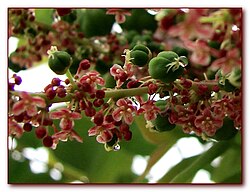Note: This is a project under development. The articles on this wiki are just being initiated and broadly incomplete. You can Help creating new pages.
Difference between revisions of "Phyllanthus acidus - Lavalīphala"
(→References) |
(→Fruit) |
||
| (2 intermediate revisions by the same user not shown) | |||
| Line 2: | Line 2: | ||
'''Lavalīphala''' consists of dried fruit of Phyllanthus acidus. Phyllanthus acidus is a small or medium sized tree cultivated in gardens, and also grown as a roadside tree. | '''Lavalīphala''' consists of dried fruit of Phyllanthus acidus. Phyllanthus acidus is a small or medium sized tree cultivated in gardens, and also grown as a roadside tree. | ||
==Uses== | ==Uses== | ||
| − | {{Uses|Asthma}}, {{Uses|Skin diseases}}, {{Uses|Itching}}, {{Uses|Fever}}, {{Uses|Urticaria}}, {{Uses|Bronchial catarrh}}, {{Uses|Eye-troubles}}, {{Uses|Constipation}}, {{Uses|Vomit}}<ref name=" | + | {{Uses|Asthma}}, {{Uses|Skin diseases}}, {{Uses|Itching}}, {{Uses|Fever}}, {{Uses|Urticaria}}, {{Uses|Bronchial catarrh}}, {{Uses|Eye-troubles}}, {{Uses|Constipation}}, {{Uses|Vomit}}<ref name="Karnataka Medicinal Plants"/> |
==Parts Used== | ==Parts Used== | ||
| − | {{Parts Used|Fruits}}, {{Parts Used|Flowers}}, {{Parts Used|Leaves}} | + | {{Parts Used|Fruits}}, {{Parts Used|Flowers}}, {{Parts Used|Leaves}}<ref name="Karnataka Medicinal Plants"/> |
==Chemical Composition== | ==Chemical Composition== | ||
| Line 36: | Line 36: | ||
===Flower=== | ===Flower=== | ||
| − | {{Flower|Bisexual||Pink||The flowers are small and pinkish and appear in clusters in 5 to 12.5 cm long panicles | + | {{Flower|Bisexual||Pink||The flowers are small and pinkish and appear in clusters in 5 to 12.5 cm long panicles. Flowering from February to March}} |
===Fruit=== | ===Fruit=== | ||
| − | {{Fruit|Berry|||The fruits are numerous, oblate, with 6 to 8 ribs, and are densely clustered. They are pale yellow or white | + | {{Fruit|Berry|||The fruits are numerous, oblate, with 6 to 8 ribs, and are densely clustered. They are pale yellow or white||Fruiting from February to March}} |
===Other features=== | ===Other features=== | ||
Latest revision as of 12:36, 8 March 2023
Lavalīphala consists of dried fruit of Phyllanthus acidus. Phyllanthus acidus is a small or medium sized tree cultivated in gardens, and also grown as a roadside tree.
Uses
Asthma, Skin diseases, Itching, Fever, Urticaria, Bronchial catarrh, Eye-troubles, Constipation, Vomit[1]
Parts Used
Chemical Composition
Triterpenoids (β- amyrin, Phyllanthol) and Gallic acid.[2]
Common names
| Language | Common name |
|---|---|
| Kannada | Arenelli, Kirunelli |
| Hindi | Harfaarevadi, Lavali |
| Malayalam | |
| Tamil | Arinelli |
| Telugu | Raachayusarike |
| Marathi | NA |
| Gujarathi | NA |
| Punjabi | NA |
| Kashmiri | NA |
| Sanskrit | Sugandhamūlā, Lavalī |
| English | Star gooseberry, Country gooseberry |
Properties
Reference: Dravya - Substance, Rasa - Taste, Guna - Qualities, Veerya - Potency, Vipaka - Post-digesion effect, Karma - Pharmacological activity, Prabhava - Therepeutics.
Dravya
Rasa
Kaṣāya, Amla, Madhura
Guna
Rūkṣa, Guru, Viśada
Veerya
Śīta
Vipaka
Madhura
Karma
Pittahara, Kaphahara, Vātakara, Grāhi, Rakta Stambhana
Prabhava
Habit
Identification
Leaf
| Kind | Shape | Feature |
|---|---|---|
| Simple | Alternate | The leaves are ovate or lanceolate in form, with short petioles and pointed ends about 2 to 7.5 cm long. They are green and smooth on the upper-side and blue-green on the underside |
Flower
| Type | Size | Color and composition | Stamen | More information |
|---|---|---|---|---|
| Bisexual | Pink | The flowers are small and pinkish and appear in clusters in 5 to 12.5 cm long panicles. Flowering from February to March |
Fruit
| Type | Size | Mass | Appearance | Seeds | More information |
|---|---|---|---|---|---|
| Berry | The fruits are numerous, oblate, with 6 to 8 ribs, and are densely clustered. They are pale yellow or white | Fruiting from February to March |
Other features
List of Ayurvedic medicine in which the herb is used
Where to get the saplings
Mode of Propagation
How to plant/cultivate
Gooseberry tree grows well in the tropics at low and medium altitudes in places with a short or prolonged dry season.[4]
Commonly seen growing in areas
Photo Gallery
References
- ↑ 1.0 1.1 Karnataka Medicinal Plants Volume - 2” by Dr.M. R. Gurudeva, Page No.211, Published by Divyachandra Prakashana, #45, Paapannana Tota, 1st Main road, Basaveshwara Nagara, Bengaluru.
- ↑ The Ayuredic Pharmacopoeia of India Part-1, Volume-5, Page no-14
- ↑ Morphology
- ↑ Cultivation detail
External Links
- Ayurvedic Herbs known to be helpful to treat Asthma
- Ayurvedic Herbs known to be helpful to treat Skin diseases
- Ayurvedic Herbs known to be helpful to treat Itching
- Ayurvedic Herbs known to be helpful to treat Fever
- Ayurvedic Herbs known to be helpful to treat Urticaria
- Ayurvedic Herbs known to be helpful to treat Bronchial catarrh
- Ayurvedic Herbs known to be helpful to treat Eye-troubles
- Ayurvedic Herbs known to be helpful to treat Constipation
- Ayurvedic Herbs known to be helpful to treat Vomit
- Herbs with Fruits used in medicine
- Herbs with Flowers used in medicine
- Herbs with Leaves used in medicine
- Herbs with common name in Kannada
- Herbs with common name in Hindi
- Herbs with common name in Tamil
- Herbs with common name in Telugu
- Herbs with common name in Sanskrit
- Herbs with common name in English
- Habit - Deciduous tree
- Index of Plants which can be propagated by Seeds
- Index of Plants which can be propagated by Greenwood cuttings
- Index of Plants which can be propagated by Budding
- Index of Plants which can be propagated by Air layering
- Herbs that are commonly seen in the region of Coastal forest
- Herbs that are commonly seen in the region of Dry limestone woodlands
- Herbs
- Ayurvedic herbs that don't have seed photos
- Phyllanthaceae





